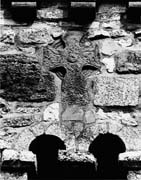Select a site alphabetically from the choices shown in the box below. Alternatively, browse sculptural examples using the Forward/Back buttons.
Chapters for this volume, along with copies of original in-text images, are available here.
Object type: Cross-head and part of -shaft [1]
Measurements: Unobtainable
Stone type: Apparently similar to no. 1.
Plate numbers in printed volume: 485
Corpus volume reference: Vol 3 p. 145
(There may be more views or larger images available for this item. Click on the thumbnail image to view.)
Only one face is visible.
A (broad): The complete cross-head is a plate head (G.I., fig. 3, 5) the arms being type E10, splayed with wide arm-pits and convex ends. The plate is recessed and has a double plain moulding, giving the appearance of a median-incised type 1(a) ring. A similar (though single) moulding runs round the perimeter of the cross-head and -shaft with no separation between the two elements. There is a central domed boss with a depression in the middle. The upper arm of the cross is very worn but there seem to be parts of a bird form bound by a trailing band. In the right-hand arm is a wing-shape. The birds, if such they be, appear to be looking back. The rest of the decoration in the lateral arms is probably loose interlace which is connected with that of the lower arm and shaft. The lower arm has a knot executed in broad strands which is broken at one side. On the shaft are, apparently, two human figures placed across each other in a saltire fashion: the legs are comparatively clear, as are the elbow and head of one figure and the shoulders of the other; the rest is obscure. Below them are two small profile human busts with domed heads. There are slender vertical shafts in front of each. The cutting on the shaft is more shallow than on the cross-head.
The plate-head form of cross is found in Allertonshire, North Riding, and on clumsier high crosses in Ireland. The introduction of any kind of ring-head into Yorkshire must date from after the Norse-Irish entry and the establishment of the York-Dublin axis from 920 onwards (Bailey 1978, 177–79). The uninterrupted flow of design from the shaft into the head has a parallel in North Frodingham 1 where there are also fettered birds in similar positions (Ills. 695). The taste for such birds is noticeable in York (Lang 1978b, 147). The paired humans need not be considered in terms of iconography since they fit into the symmetry of the design about a vertical axis. This cross is probably a local copy of more ambitious pieces from a York workshop; there are no immediately local analogues.



